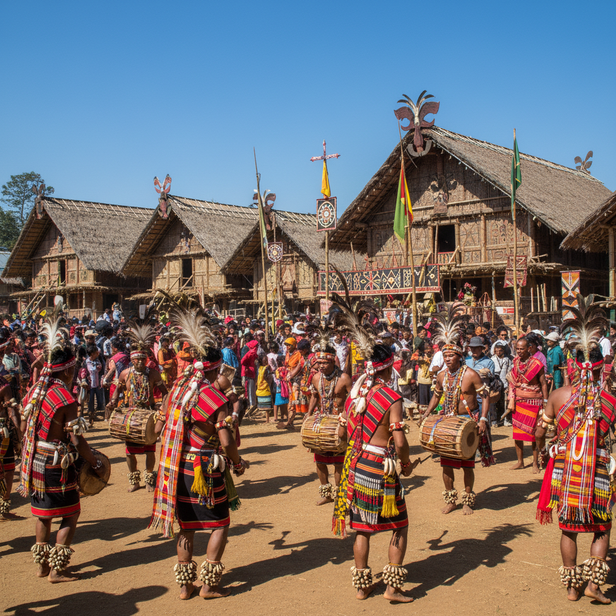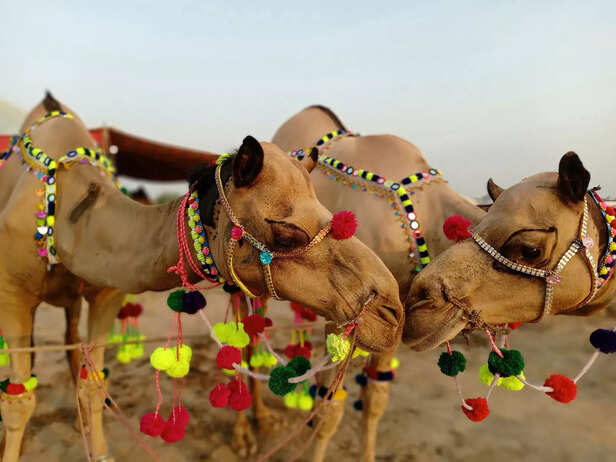Not Just for Tourists: How Indian Festivals Turn Strangers Into Believers
Megha Jangra | Sep 19, 2025, 11:00 IST
Celebrating Indian Folk Traditions
( Image credit : Pexels )
Festivals are more than moments of joy they are cultural showcases that attract travelers from across the world. Events like the Hornbill Festival in Nagaland and the Rann Utsav in Gujarat highlight India’s diversity, blending tradition, art, music, and food into immersive experiences. These festivals not only strengthen local identities but also serve as global tourism magnets. With rising interest in cultural tourism, such festivals demonstrate how India’s heritage can connect with audiences both at home and abroad.
Festivals have always been central to India’s cultural landscape. Beyond being social or religious celebrations, they are now evolving into platforms that highlight regional art, craft, food, and lifestyle to the world. As cultural tourism gains popularity globally, Indian festivals are no longer confined to local visitors they are increasingly drawing international travelers who seek authentic, immersive experiences.
Among the many festivals, the Hornbill Festival of Nagaland and the Rann Utsav of Gujarat stand out. While one celebrates tribal heritage in the Northeast, the other transforms a salt desert into a carnival of colors. Both showcase India’s cultural depth, attracting not just domestic tourists but also global audiences curious to explore traditions beyond typical tourist circuits.

Held every December in Nagaland, the Hornbill Festival is often called the "Festival of Festivals." It brings together all 17 major tribes of the state, offering visitors a chance to experience the region’s unique customs in one place.

From November to February, the white salt desert of Kutch in Gujarat transforms into a cultural extravaganza during the Rann Utsav.

1. Authentic Experiences Over Commercial Tourism
Modern travelers increasingly prefer cultural immersion over conventional sightseeing. Festivals like Hornbill and Rann Utsav offer “real India” experiences—where culture is not staged but lived.
2. A Platform for Cultural Exchange
These festivals invite musicians, artists, and performers not only from India but also abroad, creating a dialogue between cultures. This global participation strengthens their appeal.
3. Economic and Social Impact
Festivals boost local economies by creating seasonal jobs, promoting crafts, and encouraging homestays. International visitors amplify this impact by spending more on local goods and services.
4. Media and Digital Promotion
Social media campaigns and influencer travel vlogs have turned these festivals into global attractions. Hashtags, Instagram posts, and YouTube travel diaries ensure that even people who cannot attend are inspired to plan future visits.
While these festivals attract attention, challenges remain. Infrastructure in remote areas like Nagaland needs constant upgrading to cater to international tourists. Similarly, large-scale tourism in fragile ecosystems like the Rann must be managed sustainably to avoid environmental damage.
However, these challenges also bring opportunities. By investing in eco-friendly tourism and community participation, festivals can set benchmarks for responsible cultural tourism.
Festivals like the Hornbill and Rann Utsav prove that cultural tourism is not just about entertainment—it’s about preserving heritage, empowering communities, and connecting India with the world. They attract domestic audiences who reconnect with their roots and international travelers who seek authenticity beyond glossy tourist brochures.
In celebrating these festivals, India celebrates itself—its diversity, its creativity, and its openness to the world. And in a globalized age, that celebration becomes an invitation: to witness, to learn, and to belong, even if just for a few days, to a culture larger than one’s own.
Among the many festivals, the Hornbill Festival of Nagaland and the Rann Utsav of Gujarat stand out. While one celebrates tribal heritage in the Northeast, the other transforms a salt desert into a carnival of colors. Both showcase India’s cultural depth, attracting not just domestic tourists but also global audiences curious to explore traditions beyond typical tourist circuits.
The Hornbill Festival: The "Festival of Festivals"

Hornbill Festival: Nagaland’s Tribal Celebration
( Image credit : Times Life Bureau )
Held every December in Nagaland, the Hornbill Festival is often called the "Festival of Festivals." It brings together all 17 major tribes of the state, offering visitors a chance to experience the region’s unique customs in one place.
- Cultural Showcase: Traditional dances, folk songs, warrior performances, and indigenous games give audiences an immersive glimpse into Naga life.
- Food and Crafts: From spicy smoked meats to rice beer, the festival’s food stalls attract food lovers. Handwoven textiles and tribal jewelry appeal to travelers interested in artisanal crafts.
- Global Attention: Over the years, the festival has earned recognition from international travel magazines and bloggers, putting Nagaland on the global tourism map. Visitors from Europe, Southeast Asia, and the U.S. flock here to witness authentic tribal culture in a safe, accessible setting.
Rann Utsav: A Desert Carnival

Camel Charm at Rann Utsav
( Image credit : Unsplash )
From November to February, the white salt desert of Kutch in Gujarat transforms into a cultural extravaganza during the Rann Utsav.
- Scenic Backdrop: Tourists witness the surreal beauty of the salt desert under the full moon, creating a once-in-a-lifetime experience.
- Local Heritage: The festival features folk dances, handicraft exhibitions, camel rides, and kutchi cuisine. Traditional crafts like embroidery and leatherwork find international buyers here.
- Global Appeal: Luxury tents and well-organized tourist facilities make it accessible to global audiences. Travel influencers and international media coverage have made Rann Utsav a bucket-list experience for cultural travelers worldwide.
Why Do These Festivals Attract Global Audiences?

Global Appeal of Indian Festivals
( Image credit : Times Life Bureau )
1. Authentic Experiences Over Commercial Tourism
Modern travelers increasingly prefer cultural immersion over conventional sightseeing. Festivals like Hornbill and Rann Utsav offer “real India” experiences—where culture is not staged but lived.
2. A Platform for Cultural Exchange
These festivals invite musicians, artists, and performers not only from India but also abroad, creating a dialogue between cultures. This global participation strengthens their appeal.
3. Economic and Social Impact
Festivals boost local economies by creating seasonal jobs, promoting crafts, and encouraging homestays. International visitors amplify this impact by spending more on local goods and services.
4. Media and Digital Promotion
Social media campaigns and influencer travel vlogs have turned these festivals into global attractions. Hashtags, Instagram posts, and YouTube travel diaries ensure that even people who cannot attend are inspired to plan future visits.
Challenges and Opportunities
However, these challenges also bring opportunities. By investing in eco-friendly tourism and community participation, festivals can set benchmarks for responsible cultural tourism.
The Last Word
In celebrating these festivals, India celebrates itself—its diversity, its creativity, and its openness to the world. And in a globalized age, that celebration becomes an invitation: to witness, to learn, and to belong, even if just for a few days, to a culture larger than one’s own.
